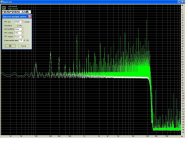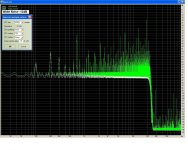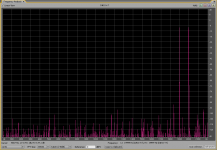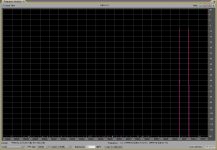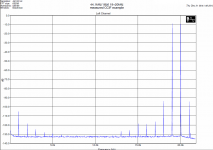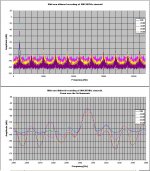Maybe. But in my experience, twin-tone testing method is more sensitive. With multitones I usually get nothing (just a nice plot), as the amplitudes of spectral lines in multitone or noise are much lower than those in the twin-tone. IMO the twin-tone tuned over certain frequency range is a good, reliable and repeatable method.
Agreed. Twin tone or multitone testing produces coherent spurious responses that are far easier to detect, measure, and analyze than those from random noise sources.
This is true in listening tests, and it is also true with measurements. Multitone testing and FFT-based analyzers seem to be made for each other.
No dither used for the test CD signal generation? It should be clean, normally. This looks like undithered.
Oh, you mean the TRUE CD distortion measurement? '-)
No.
This is a very sad thing to see.
I am analyzing a few wav files from CD players done with various excitation waveforms and these two give almost identical FFTs (same equipment, same setup)
George
George, links to dithered and undithered signals (to burn to CD, EAC is best, do not use WMA player or similar)
http://pmacura.cz/19+20_dithered.zip
http://pmacura.cz/19+20_undithered.zip
Please see the spectra of the dithered and undithered signal and spectrum of measurement of analog output with dithered 44.1/16 19+20kHz signal. You should see only 19kHz, 20kHz and intermodulation products, that must be only multiples of 1kHz. No quantization error lines, please.
Attachments
Last edited:
Oh, you mean the TRUE CD distortion measurement? '-)
This is interesting and educational why try to obfuscate it to push your own agenda regarding digital and it sounding bad compared to the best analogue has to offer (LPs)!
No dither used for the test CD signal generation? It should be clean, normally. This looks like undithered.
Ouch !
Not much of a trouble. There were just 696 files recorded these days and I have looked into only a dozen of them.
Pavel, had you replied yesterday night, I would have lost sleep.
But as you are a very kind person, you let me enjoy a very good sleep, so I can take the early morning punch with only a truckload of #@%!!&*.
Let’s take the bright side of it.
I constructively filled up three days of my life feeling I do a remarkable job, a great feeling.
I created a unique new set of waveforms, opening up new frontiers for the global technology to explore, a great feeling.
I reconfirmed my stupidity, a great feeling (stupidity is unbeatable they say, so am I).
And I was wondering what this repetitive pattern at the FFTs may mean…
There may be some interesting –useful- outcome in the end by using these non dithered waveforms. I notice some promising strong waviness resulting, waviness of the kind you mentioned in posts # 77184, 77200, 77205, 77215. I’ll look into it later when I compare results using dithered waveforms.
For now, two FFTs from non dithered vs dithered sinuses I had done last Feb ( and this is that really worries me, I should have remembered this. My memory fades away).
Thank you again Pavel (experience and expertise in spades)
George
Attachments
Last edited:
Exploration makes a good feeling and this is a very nice hobby 😉. There is nothing above own experience, it is unforgettable. Have a great New Year, George!
I can't say whether the dithered or undithered measurement is really the most accurate. However, I am suspicious that what we hear is not what we measure, (dithered). I could be wrong, but I am not yet convinced otherwise.
I also have a 105 that I think I will do some testing on. Go R.Marsh go! You have better test equipment than most of these guys. '-)
I also have a 105 that I think I will do some testing on. Go R.Marsh go! You have better test equipment than most of these guys. '-)
Just another example of why Psychoacoustics needs to be taught more widely.
George, thank-you for the smile.Ouch ! ...
Happy new year to you (and all the members of this forum aq well).
I can't say whether the dithered or undithered measurement is really the most accurate.
Yes, I'm sure you can't.
I can't say whether the dithered or undithered measurement is really the most accurate.
More to the point it is hard to find a signal to measure out in the real world that is not noisy enough to be dithered.
However, I am suspicious that what we hear is not what we measure, (dithered). I could be wrong, but I am not yet convinced otherwise.
The human ear? Talk about a noisy place!
I can't say whether the dithered or undithered measurement is really the most accurate. However, I am suspicious that what we hear is not what we measure, (dithered). I could be wrong, but I am not yet convinced otherwise.
I also have a 105 that I think I will do some testing on. Go R.Marsh go! You have better test equipment than most of these guys. '-)
Sorry, this is the deepest misunderstanding so far!
It is not the measurement that is dithered, test signal is dithered before burned to CD!!! Every 44.1/16 PCM/wav must be dithered, including music and every mastering step! 40 years ago this was not well recognized and was the source of bad sound of some early digital recordings. Measurement is always the same, independent on dither yes/no of the test signal.
We usually meet the lack of essential knowledge, here. No "better equipment" is able to cure this. If wrongly used, the result is wrong.
Last edited:
This I don't understand. Once the noise is in, to random one step error, it is forever, not ? And I suppose that, in real music, the acoustic one of the studio, even in a sigle track is enough to 'dither' the all thing , not ?including music and every mastering step!
Pavel,
I thought you had picked up a bit from JC I didn't realize you were try to channel SY.
Have you ever listened to that Aretha Franklin song?
Yes the way JC posted is showing a lack of understanding.
But it does raise an interesting question, what do things sound like when we deliberately add noise to the output. I know you have played with this as have I.
Now for my work adding noise to the announcers headphones has some interesting effects, totally unrelated to the topic under discussion.
I thought you had picked up a bit from JC I didn't realize you were try to channel SY.
Have you ever listened to that Aretha Franklin song?
Yes the way JC posted is showing a lack of understanding.
But it does raise an interesting question, what do things sound like when we deliberately add noise to the output. I know you have played with this as have I.
Now for my work adding noise to the announcers headphones has some interesting effects, totally unrelated to the topic under discussion.
This I don't understand. Once the noise is in, to random one step error, it is forever, not ? And I suppose that, in real music, the acoustic one of the studio, even in a sigle track is enough to 'dither' the all thing , not ?
When to dither ? Always !
- Status
- Not open for further replies.
- Home
- Member Areas
- The Lounge
- John Curl's Blowtorch preamplifier part II
